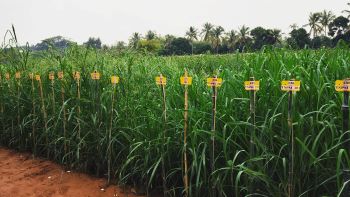For more information
Media Relations
Agriculture and Agri-Food Canada
1-866-345-7972
aafc.mediarelations-relationsmedias.aac@agr.gc.ca
Hearty, nutritious and versatile, millet is one of Canada’s lesser known cereal crops. While it is often thought of as animal feed or bird seed in this country, it has many applications and is an important staple food source in many areas of the world.
An ancient cereal, millet is considered a super grain – naturally gluten-free, nutritionally dense and a rich source of protein, fibre and essential minerals like iron and zinc. It’s also a climate resilient and sustainable crop, able to withstand short growing seasons, poor soils and environmental stress, with low fertilizer and irrigation needs. This versatility also makes millet an excellent forage or cover crop, and it even shows promise as an effective bio-fuel.
With stats like these, it’s no wonder the Food and Agriculture Organization (FAO) of the United Nations has declared 2023 the International Year of Millets.
To help celebrate, we’re featuring some of the important research Agriculture and Agri-Food Canada (AAFC) scientists from across the country are leading on this mighty little super food and adaptable crop.
The mighty little millet
Little millet (Panicum sumatrense), a member of the millet family grown mainly in southeast Asia and Africa, is an annual grass with tiny seeds that could make a global impact on nutrition security. About 25% of the world’s population suffers from “hidden hunger” caused by eating food that is low in nutrients and vitamins. Little millet is a nutritionist’s dream: rich with fiber, protein, antioxidants and minerals like zinc and iron. And with a short life cycle (about 80 days) and high environmental stress tolerance, this nutritional powerhouse can be successfully grown in many areas of the world – including Canada.
Unfortunately, despite the crop’s potential, little millet is among the least studied crops. Dr. Raju Soolanayakanahally, an AAFC scientist in Saskatoon, is working with research partners in India at the University of Agricultural Sciences, Bangalore to change that. Together, they have created a roadmap for future study of little millet using vast genetic resources. The result is a genetic atlas of the different stages in the little millet plant’s life cycle to identify the super-food properties of this cereal plant.
The atlas is an important step toward uncovering the genetic networks that give this cereal plant its unique nutritional and stress tolerant features. This data could be used to breed new improved varieties with enhanced uptake of iron and zinc, ultimately helping to curb hidden hunger around the world.
The benefits of millet as a cover crop
On Prince Edward Island, where spuds are the cream of the crop, Dr. Judith Nyiraneza is researching ideal “high residue” cover crop mixes that can improve soil health and potato yields as part of AAFC’s Living Lab – Atlantic initiative. When crops are harvested they can leave materials in the soil called crop residue. This residue, if incorporated into the soil, can increase the yield of next season’s crop, and can store more carbon in soils, which helps lower greenhouse gas emissions.
One of the cover crops that caught the eye of Dr. Nyiraneza was pearl millet, an annual grass crop, that usually grows one-to-three metres high. A relatively new crop for PEI farmers, Dr. Nyiraneza was keen to see how pearl millet stood up to other effective cover crops like sorghum sudan grass. She discovered that pearl millet was returning more carbon to the soil than any other cover crop she researched, while also reducing harmful nitrates from entering soils and increasing potato yield. Pearl millet can even reduce root-lesion nematode populations, microscopic worm-like organisms that target roots causing yield loss. Dr. Nyiraneza’s research further solidifies pearl millet as a valuable and versatile crop for potato farmers and the environment.
Seeing double: the dual benefits of sweet pearl millet and sweet sorghum
In Eastern Canada, researchers are busy exploring ways to maximize the potential of sweet pearl millet and sweet sorghum as dual purpose crops – providing both raw materials for bioethanol, a renewable energy source, and good-quality silage.
Dr. Annick Bertrand and Dr. Gaëtan F. Tremblay, AAFC research scientists at the Quebec Research and Development Centre, have set out to prove the dual benefits of these crops as both fuel and food. Harvested plants can be pressed in-field; the juice extracted from pressing can be used for bioethanol production, while the remaining residue, called the bagasse, provides silage. However, it’s a balancing act to ensure enough carbohydrates are extracted from the juice for fuel and enough nutrients are retained in the bagasse for silage.
Dr. Bertrand and Dr. Tremblay were able to optimize a process for in-field pressing. Their work shows that the plant biomass can be pressed twice, with a favourable water to bagasse ratio. The resulting juice is effective for bioethanol production, while the bagasse still retains sufficient carbohydrate and nutrient composition to provide good-quality silage.
With work like this going on in Canada alone, it’s easy to see why the FAO has chosen to declare 2023 the International Year of Millets.
Key Facts
- The Food and Agriculture Organization of the United Nations has declared 2023 the International Year of Millets.
- Millet is an ancient grain and superfood, and a resilient and sustainable crop. Nutritionally dense and versatile, millet has great potential and many uses, including: forage, cover crop, silage, biofuel and an important nutrition source around the world.
- AAFC scientists from across the country are hard at work conducting research to help maximize the potential of this small but mighty grain.
Photo gallery

Field of millet
Credit: Marie-Noëlle Thivierge ©AAFC, 2010

Dr. Judith Nyiraneza, research scientist at Charlottetown Research and Development Centre, working in field during cover crop trials.

Little millet field grown in a research field at the University of Agricultural Sciences, Bangalore.